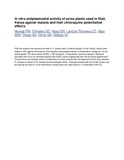| dc.contributor.author | Muregi, FW | |
| dc.contributor.author | Chhabra, SC | |
| dc.contributor.author | Njagi, EN | |
| dc.contributor.author | Lang'at-Thoruwa, CC | |
| dc.contributor.author | Njue, WM | |
| dc.contributor.author | Orago, AS | |
| dc.contributor.author | Omar, SA | |
| dc.contributor.author | Ndiege, IO | |
| dc.date.accessioned | 2013-12-04T14:03:54Z | |
| dc.date.available | 2013-12-04T14:03:54Z | |
| dc.date.issued | 2003 | |
| dc.identifier.citation | J Ethnopharmacol. 2003 Feb;84(2-3):235-9. | en_US |
| dc.identifier.uri | http://www.ncbi.nlm.nih.gov/pubmed/12648820 | |
| dc.identifier.uri | http://hdl.handle.net/11295/61791 | |
| dc.description.abstract | Fifty-five organic and aqueous extracts of 11 plants used in malaria therapy in Kisii District, Kenya were tested in vitro against chloroquine (CQ)-sensitive and resistant strains of Plasmodium falciparum. Of the plants tested, 73% were active (IC(50) < 100 microg/ml). Three plants, Vernonia lasiopus, Rhamnus prinoides and Ficus sur afforded extracts with IC(50) values ranging less than 30 microg/ml against both CQ-sensitive and resistant strains. Combination of some extracts with CQ against the multi-drug resistant P. falciparum isolate V1/S revealed some synergistic effect. The plant extracts with low IC(50) values may be used as sources for novel antimalarial compounds to be used alone or in combination with CQ. | en_US |
| dc.language.iso | en | en_US |
| dc.publisher | Elsevier | en_US |
| dc.title | In vitro antiplasmodial activity of some plants used in Kisii, Kenya against malaria and their chloroquine potentiation effects. | en_US |
| dc.type | Article | en_US |

